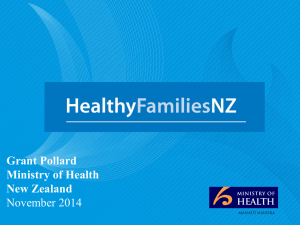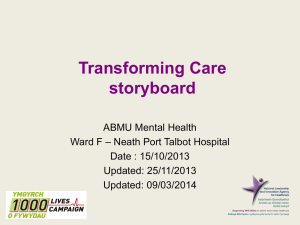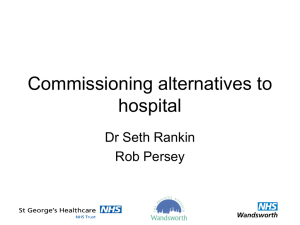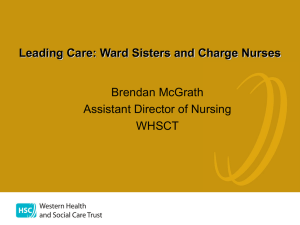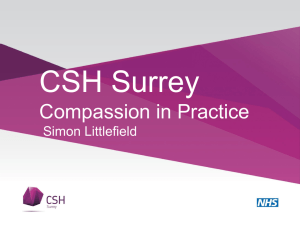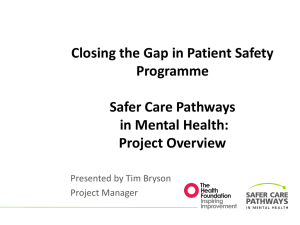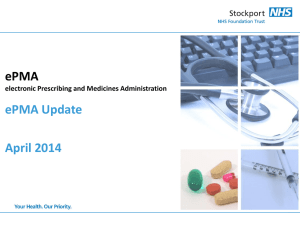Ward Rounds
advertisement
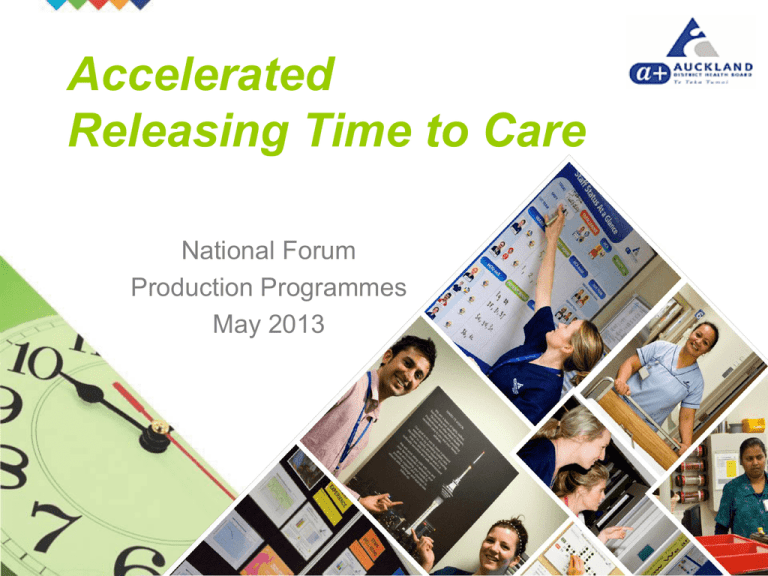
Accelerated Releasing Time to Care National Forum Production Programmes May 2013 Background • ADHB commenced Releasing Time to Care is 2009 with 33 Wards now underway • ADHB investigated alternative delivery options for RTC • An accelerated approach was chosen with a pilot ward commencing in July 2012 • Support resource was allocated to work with the team to deliver on a module a month until completion Foundation Modules Knowing How We are Doing Well Organised Ward Patient Status at a Glance Nursing Procedures 7-9 Months Nursing Procedures Nursing Procedures Ward Rounds Admissions and Planned D/C Medicines Patient Hygiene Patient Observations Meals Shift Handover Process Modules Accelerated Programme Approach Ongoing Module Implementation – Monthly timeline Preparation •Agree team and confirm roster •Collect Data Week 1 Launch •Patient Interviews •Staff Interviews •Process follows •Learn from other Wards •Review data •Generate excitement Week 2 & 3 Develop •Develop Process Flowchart •Develop SOPs Week 4 Implement Follow Up •Staff Education •New equipment •Go Live with process improvements •Facilities improvements •Develop Templates •Audits •Go-see •Engage other stakeholders •Celebrate success •Identify opportunities •Order new equipment •Define new process •Plan facilities improvements •Agree implementation timeframe and communications plan Key Principles • Steal with pride - capitalise on the work done and improvements made by other wards • Manage scope – focus on specific areas of improvement • Communication, Communication, Communication – use the Daily Ward Meetings as a key tool to ensure everyone knows what is happening, why and when • Quick fire – keep energy, focus and motivation high by maintaining momentum • Share the load – utilise as many of the ward team as possible to implement change • Build for the future – develop resources to be utilised by other wards Results - Overall 7 Process Modules delivered Direct Care Time = 54% (38% Improvement) Patient Satisfaction = 91 % 3 Foundation Modules extended Staff Satisfaction = 84 % Reduction in Pressure Injuries = 0 in 6 months Reduction in Length of Stay >0.8 days Sustained Smoking Cessation >95% Sustained Acute Patient Flow >95% “It really has increased the amount of time we can spend with the patients” – Staff Member Knowing How We are Doing •Revisited the Ward Vision with input from the Multidisciplinary team •Implemented Daily Ward Meetings •Maintained communications boards and safety crosses “The atmosphere on the ward has changed. You can feel it as you walk in, things are calm and organised.” - Staff Member Well Organised Ward •4 bedded Rooms •Equipment Room •Staff Base •Whanau Room •Education Hub •Ward Meeting Room •Sluice Room “I can find things! Everything has its place.” – Staff member Patient Status at a Glance •Electronic Whiteboards updated with required flags •New wide screens to improve usability •Patient Bedcards implemented •Staff Status at a Glance Board •Rapid Rounds maintained Shift Handover •ISOBAR Bedside Handover •Patient involvement •Improved information transfer •Safety checks •Significant impact on direct care time “When the nurses change shifts they introduce who they are and that they’re our nurse” - Patient Meals •Improved focus on patient preparation •Implementation of a meal preparation bell •Nurses assisting patients to complete meal cards – ensuring sufficient food is ordered and less meal call backs are required •Improved use of assist flags for those patients needing any assistance at meal times •Improved timing of meal delivery Patient Observations •Improved observation trolley set up to reduce waste looking for additional equipment •Relocation of observation equipment to point of use (i.e. within 4-bedded rooms and outside single bedded rooms) •Refreshed patient observation standards including education “The ward seems calm and everyone knows what they are doing.” - Patient Patient Hygiene •Hygiene packs •Where am I posters for Commode and Wash Bowl Trolley •Agreed standards on patient hygiene requirements “The staff are fantastic! I would give them 100%. They work so hard and every single one of them took time for a chat and you were never rushed.” - Patient Medicines •New layout and refurbishment of the medication room •Improved access to controlled drugs cabinet •Reduce stock levels •Improved education for patients Admissions and Planned Discharges •New patient welcome pack including –Ward information Booklet –Ward and hospital maps –What to expect information –Transition lounge brochure –Hospital Resources •Staff Admission checklist •Agreement that discharge summaries are written 24 hours before discharge to allow for review by the consultant and better discussion with the patient Ward Rounds •Agreed sequence and flow •Portable laptop to be used during Ward Rounds •Patient nurse to attend Ward Rounds •Ward Rounds information sheet for patients in the Welcome Pack including space to capture questions for the Medical Team •Improved signage and awareness around which teams are rounding and when •Consultant to sit down during Ward Rounds to enable better engagement with the patient and their support person(s) •Junior doctor to read back plan to ensure clarity and correctness Conclusion •Ward 72 has benefited from the combined impact of the Accelerated Releasing Time to Care programme, Rapid Rounds and daily ward meetings •The ward is now better organised with clearly defined processes. •The improvements have resulted in a calmer work environment that provides a better patient experience •The fast pace of implementation along with the significant team involvement has resulted in a continuous stream of improvements on the ward keeping team motivation and engagement high “Getting better every day! Great place to work!” - Staff member Questions Do you have any questions? For future questions please contact Abbi Harwood-Tobin (abbih@adhb.govt.nz or 021 584 021) Marie Mata (mmata@adhb.govt.nz or 021 0825 7224) Sarah Wilson (sarahwil@adhb.govt.nz 021 397 553) “It means nurses can identify REAL problems… and fix them!” - Staff Member

